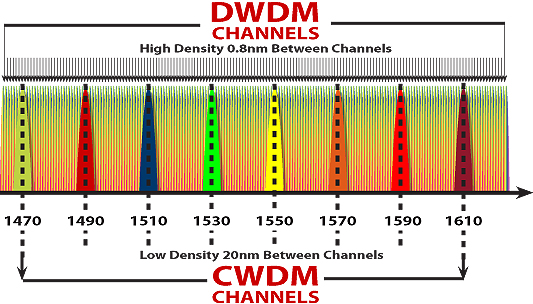Both Coarse Wavelength Division Multiplexing (CWDM) and Dense Wavelength Division Multiplexing (DWDM) optical transport solutions are available as active or passive systems.

CWDMs utilize a channel spacing of 20nm, where a DWDMs utilize much denser spacing typically 0.8nm
Passive
In a passive (or non-powered) optical transport solution, either a CWDM or DWDM transceiver resides directly inside a device, such as a data switch or a router.
A typical example of this would be an IP switch that has a channelized SFP pluggable optic that is tuned to a specific CWDM or DWDM wavelength. The output from the channelized SFP transceiver connects to a corresponding passive multiplexer that combines and redistributes, or multiplexes and demultiplexes, the various wavelength signals.
As the channelized CWDM or DWDM pluggable SFP transceiver resides in the data switch or router, it means that the xWDM functionality is inherently embedded within the respective device.
Active
Active optical transport solutions have AC- or DC-powered components and are stand-alone systems separated from the devices that connect to them, such as data switches and routers.
A primary task of a stand-alone optical transport system is to take a short-range output signal and extend the reach of the signal while also converting it to a channelized CWDM or DWDM wavelength.
A typical example of Active DWDM Componentry:
An IP switch that has a 10Gb port populated with a ‘gray’ 1310 SFP+ optic, where the interface from the 1310 SFP+ port on the IP-switch is then cross-connected via a fiber jumper to the client interface port of a Transponder Card within an active optical transport system. A Transponder is a component that receives an incoming optical signal and then converts it to a channelized xWDM wavelength.
The active optical transport system then takes converted xWDM signals, combines them and transmits them with the help of some additional components, including passive multiplexers, and amplifiers if necessary, for long-haul applications. Due to the separation of the xWDM transport functionality from the endpoint device, such as a data switch or router, active optical transport systems also tend to be more complex than passive solutions.
Passive DWDM:
Advantages:
- Easier Setup – Plug and play simplicity. There is no need to tune wavelengths for all the connections.
- Cost-effective Solution – Fewer components & less engineering time. The high-channel density substantially saves on long and short-term expenses.
Disadvantages:
- Limited Scalability – The DWDM network is restricted to fewer wavelengths on the transport fiber. Thus, more passive components will be adopted when expanding as the network grows. However, the more passive devices, the more difficult it can be to manage.
- Inconvenient Control – If you need to change a wavelength or connection, you’ll have to take the network out of service and disconnect the physical cabling as the wavelength is tied to the specific optical cable.
Active DWDM:
Advantages:
- Increase in Capacity With Reduced Fibers – Fitting more wavelengths onto a single fiber. This single fiber can carry more bandwidth. Fewer physical fibers will be used between the two sites.
- Flexible in Setups – Dynamically re-tune wavelengths without dropping connections. This may allow more control over the optical network.
- Easier Scalability – Normally, active DWDM can be easier to scale as the network grows.
Disadvantages:
- Expensive – The overall active DWDM setup fees are much more expensive compared to passive DWDM solutions. However, in the long term, this initial cost has an abundance of benefits.
- Complex in Configuration – There are many more components involved in active networks. Thus, the configuration will be a serious undertaking and require a solid understanding of optical networks.
The Decision:
Whichever you decide on, Active or Passive DWDM, the selection is will be dependent on several factors:
- Distance requirements
- Network scalability
- Initial installation & future management
- Budget
- Technical ability
If there are no requirements for the distances and future network upgrades, the passive DWDM provides user-friendly and cost-effective solutions and is suitable for those with a tight budget.
If you have high bandwidth demands and are looking for a long-haul application with convenience when changing and making upgrades in the future, the active DWDM solution may be your best fit.
